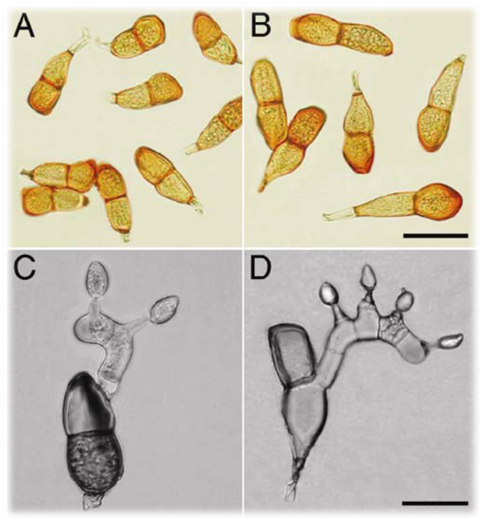Exploring the Taxonomy, Life Cycle, and Ecological Impact of Puccinia: A Comprehensive Scientific Investigation
Puccinia represents a genus of rust fungi within the phylum
Basidiomycota. These rust fungi are renowned for the distinctive rust-colored
spore masses they generate on infected plants. The impact of Puccinia species
can be substantial, leading to both economic and ecological consequences as
plant pathogens. The complex life cycle of these fungi involves a combination
of asexual and sexual reproduction, often necessitating two different host
plant species for the completion of their life cycle.
Taxonomic Hierarchy of Puccinia:
- Kingdom:
Fungi
- Phylum:
Basidiomycota
- Subphylum:
Pucciniomycotina
- Class:
Pucciniomycetes
- Order:
Pucciniales
Within the order Pucciniales, Puccinia stands as a diverse
and expansive genus, encompassing numerous species that infect various plant
hosts. This taxonomic hierarchy reflects the evolutionary relationships and
systematic classification of Puccinia within the fungal kingdom. The study of Puccinia
and rust fungi is essential for gaining insights into plant pathology,
understanding agricultural impacts, and comprehending the broader ecological
interactions between fungi and plants.
Symptoms:
- On
Wheat: Manifestation of brown pustules that eventually turn black. The
grains undergo shriveling and a reduction in weight, thereby diminishing
the quality and quantity of crop yield. However, it's important to note
that the parasite does not necessarily kill the plant.
- On
Barberry: Infection initiates on the dorsal surface of the leaf in the
form of small, dark-colored, flask-shaped pycnia, resembling yellow spots.
Beneath these pycnia, on the ventral surface, cup-like projections of
aecia or aecidia appear.
Life Cycle:
- Puccinia
graminis on Wheat: The first signs appear in early March in the
form of elongated radish-brown granular sori, known as uredosori.
- Uredinial
Stage: Uredospores, one-celled and two-nucleus spores, are formed on
stalks. These spores exert pressure on the underlying epidermis, leading
to the breakdown of the host epidermis and the formation of uredinia.
- Dispersal
of Uredospores: Wind disperses these spores, which can only infect
wheat plants.
- Telial
Stage: Uredosori change color, becoming dark brownish to dark reddish
or blackish rusty, leading to the name "black rust." New spores,
called teleutospores, are produced.
- Dispersal
of Teleutospores: Wind disperses these spores, and they do not
germinate in unfavorable conditions, reducing metabolic activity.
- Basidial
Stage: Teleutospores germinate to produce a germ tube known as
pro-mycelium or epibasidium. The fusion of nuclei leads to the formation
of diploid nuclei, which, after meiosis, result in the production of four
haploid nuclei. These nuclei migrate into the promycelium, dividing into
four cells, each forming a lateral sterigma. Basidiospores, produced on
the sterigma, are one-celled and one-nucleated.
- Basidiospore
Dispersal: These spores cannot infect wheat plants but infect the
alternate host Berberis vulgaris.
- Germination
of Basidiospores: When these spores land on the leaf surface, they
germinate, producing a short germination tube that enters the epidermal
cell. Hyphae grow in each direction, ramifying the mesophyll tissues, and
obtain nutrients by sending haustoria into the cell.
- Pycnidial
Stage: The mycelium produced by the germination of basidiospores is
monokaryotic. It forms small knots just below the upper epidermis,
transforming these cells into flask-shaped cavities called spermatia.
Spermatia are released through an ostiole, dispersed by wind.
- Dikaryotization:
When a spermatium becomes attached to the receptive hyphae of the opposite
sexual phase, its nucleus enters the receptive hyphae, resulting in
dikaryotic mycelium.
- Aecial
Stage: Dikaryotic mycelium migrates towards the lower epidermis,
forming aecidio mother cells that produce aecidiospores enclosed in
aecidial cups.
- Germination
of Aeciospores: These spores do not attack the barberry plant but can
only infect the wheat plant.
In conclusion, Puccinia stands as a captivating genus
of rust fungi, showcasing the intricacies of its life cycle, the economic
repercussions it poses as a plant pathogen, and its ecological interactions
with diverse host plants. The ability of Puccinia to undergo both
asexual and sexual reproduction, coupled with its dependency on different host
species, adds a layer of complexity to its biology. The study of Puccinia
is not only pivotal for understanding and managing plant diseases in
agriculture but also holds broader significance in unraveling the dynamics of
fungal-plant interactions within ecosystems. As ongoing research continues to
deepen our understanding of Puccinia, it contributes valuable insights
into the delicate balance between pathogens and their host plants in the
intricate web of ecological relationships.
Frequently Asked Question (FAQs)
- What
is Puccinia?
- Puccinia
is a genus of rust fungi known for causing plant diseases, particularly
on various crops.
- How
does Puccinia affect plants?
- Puccinia
species are plant pathogens, causing diseases that can lead to reduced
crop yields and economic losses.
- What
are the symptoms of Puccinia infection on wheat?
- Symptoms
on wheat include the appearance of brown pustules that later turn black,
with shriveled grains and reduced crop quality.
- Does
Puccinia kill the host plant?
- While
Puccinia can cause significant damage, it typically does not kill the
host plant.
- What
is the alternate host of Puccinia graminis?
- Puccinia
graminis has an alternate host, often found in barberry plants (Berberis
species).
- How
does Puccinia reproduce?
- Puccinia
exhibits a complex life cycle involving both asexual (uredinial and
pycnial stages) and sexual (telial and basidial stages) reproduction.
- What
is the economic impact of Puccinia on agriculture?
- Puccinia
can have significant economic impacts by reducing crop yields and
affecting the quality of harvested produce.
- Can
Puccinia infect multiple plant hosts?
- Yes,
Puccinia species are known to infect various plant hosts, contributing to
their wide-ranging ecological impact.
- How
are Puccinia spores dispersed?
- Puccinia
spores, including urediniospores and teliospores, are dispersed by wind,
contributing to the spread of the fungus.
- Is
there a way to control Puccinia infections in crops?
- Control
measures include the use of fungicides, breeding for resistance, and
cultural practices to minimize the impact of Puccinia on crops.











.jpg)




0 Comments